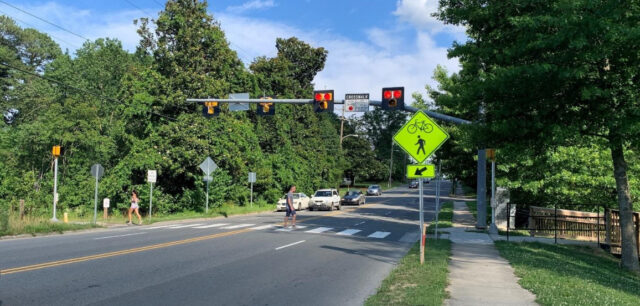STEP into trail crossings
FHWA promotes Safe Transportation for Every Pedestrian (STEP) program
by Becky Crowe, Transportation Specialist, Federal Highway Administration Office of Safety

A trail crossing in Durham, NC with a pedestrian hybrid beacon. Photo credit: FHWA
Shared use paths and trails are popular with pedestrians and cyclists, and trail-roadway crossings are increasingly important locations to consider for safety improvements. Where trails of national significance pass through urban areas, such as the Potomac Heritage National Historic Trail in the Washington, D.C. area, officials will improve crossings with signs, high visibility crosswalks, and other devices to improve the visibility of pedestrians.
These and other safety improvements are the focus of the Federal Highway Administration (FHWA) Safe Transportation for Every Pedestrian (STEP) program. STEP promotes several proven safety countermeasures, including pedestrian refuge islands and pedestrian hybrid beacons (PHBs), for improved safety at pedestrian crossings. The STEP program released the FHWA Guide for Improving Pedestrian Safety at Uncontrolled Crossing Locations (2018) to be a resource for evaluating roadway crossings not controlled by traffic signals and to help identify options for countermeasures.
The FHWA guide can also be a resource for creating an inventory of trail-roadway crossings. States and regional organizations are creating these inventories to prioritize where to implement safety improvements. A trail-roadway crossing inventory will often include information about the roadway, traffic speed, surrounding land uses, and crosswalk features.
Learn how your agency or nonprofit can improve pedestrian safety with STEP:
safety.fhwa.dot.gov/ped_bike/step/
Rebecca.Crowe@dot.gov
Peter.Eun@dot.gov